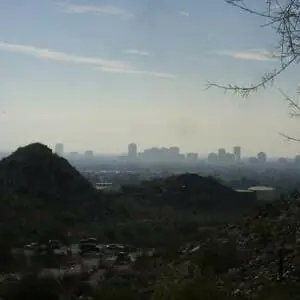
In honor of the 50th Anniversary of Earth Day, we are reaffirming our commitment to protecting and promoting the natural environment and local communities. Access to healthy environments is of primary importance, now more than ever.
The coronavirus pandemic has challenged our economic, social, and cultural systems, dramatically changed our daily lives, and created added uncertainty to future plans. At the Healthy Urban Environments Initiative (HUE), we are committed to protecting the health and safety of our community of researchers, innovators, and stakeholders. We are concerned about the impact of increasing urban heat during social distancing requirements and the greater vulnerability to COVID-19 for those in areas of poor air quality especially in the upcoming hot summer months.
The mission of HUE, though unchanged, becomes more significant and urgent.
HUE is committed to improving thermal comfort and decreasing air pollution exposure for all residents and communities in Maricopa County. We are striving to serve as a nationally recognized model for creatively managing urban heat and air quality. HUE remains a research, policy and tech incubator that rapidly develops, tests, and deploys heat-mitigation and air-quality solutions.
With funding provided by the Maricopa County Industrial Development Authority, nine projects are supported this year, adding to the portfolio of eight projects funded last year. Some projects have been delayed or have adjusted their scope, but none have been derailed due to the COVID-19 pandemic.
Examples of supported projects:
HeatReady City/ HeatReady Schools
HeatReady seeks to establish new standards and models for city-based regional heat governance to ensure a comprehensive, integrated, and effective approach to improving heat resilience across multiple scales. This HUE project team is developing a set of standards analogous to the StormReady Certification Program and STAR Community Rating System that is specifically tailored for the distinctive challenges cities face in managing risks associated with extreme heat.
High temperatures affect student behavior and cause students to be listless, fatigued, and restless,which impacts their educational environment and potentially compromises learning. Playgrounds and schoolyards have minimal shade and higher surface temperatures, creating miniature urban heat islands. Capitalizing on the City of Phoenix “HeatReady” program underway, “HeatReady Schools” a second year HUE project, targets schoolchildren and promotes heat preparedness within schools to mitigate high temperatures and health concerns. The goal is to create an evaluation tool whereby Heat Ready Schools are those that are increasingly able to identify, prepare for, mitigate, track, and respond to the negative impacts of heat.
Quantifying the Air Quality Benefit of a Novel Dust Suppression Technique
Arid urban environments often exhibit increased levels of suspended particles due to dust entrainment from uncovered land surfaces. This issue is particularly salient at or near urban construction sites, where water is commonly used as an effective but temporary solution to increase soil moisture and decrease fugitive dust entrainment rates. This HUE project will evaluate the impacts and long-term effectiveness of a novel enzyme induced carbonate precipitation (EICP) to improve soil stability and mitigate fugitive dust. EICP is a permanent and environmentally benign technique that will be tested in-situ at two different field test sites in the Phoenix Metro Area. EICP effectiveness will be determined using Clarity Air Monitoring sensors and intensive sampling conducted on-site.
Benefits of Reflective Parking Lot Coatings for mitigating heat in Maricopa County
The development of Maricopa County with widespread impervious surfaces has contributed to the urban heat within the city. Municipalities have begun to experiment with heat mitigating grey-infrastructure such as reflective asphalt coatings to lower urban temperatures. Maricopa County will apply a reflective asphalt emulsion sealcoat to 50% of a recently asphalted downtown parking lot. The first phase of the project will measure the surface energy balance and near-surface temperatures before and after coating application. The second phase will simulate widespread implementation of reflective coatings for the total parking lots in Maricopa County. The final phase is a benefit-cost analysis of the various application scenarios across Maricopa County. The findings from this research will guide future implementation of reflective coatings.